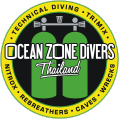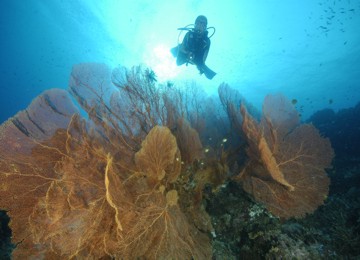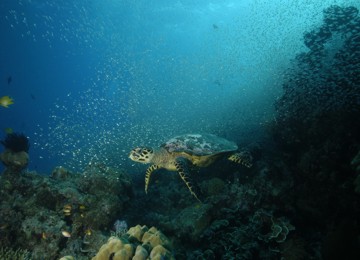




Phuket Daytrips - Similans
The Similan Archipelago composed of nine small islands is rated in the top ten of world class diving sites. Huge granite boulders overgrown with coral and algae lie jumbled together all the way from the surface to the sea bed, providing interesting swim through's, canyons, archways and caverns. The Similan are blessed with the richest variety and abundance of reef fish in Thai waters, only matched by Hin Deang and Hin Muang. Large pelagic's, such as mantas and whale sharks, visit the area on a regular basis (particularly in late March and early April during the planktonic blooms).


The only boats capable of reaching Similan Islands are specially designed diving speed boats. The usual departure time is 06h00 and return time is 18h30. Speed boats are available every day.
Monday |
Tuesday |
Wednesday |
Thursday |
Friday |
Saturday |
Sunday |
||||||||
| Speed Boats | ||||||||||||||
Koh Huyong (Island No.1)
Southeast point 18-40m (Island No1)
Large granite boulders lie jumbled from the surface to beyond 40m, providing caverns, ledges and archways, covered with hard corals and feather stars, on the shallower parts. Soft corals, gorgonian sea fans and wire corals inhabit the deeper reaches. This is also a good spot to encounter resting leopard sharks and stingrays in the 25m range depths. Large schools of tuna, giant barracudas, surgeonfish, snappers and large groupers are always residents.
Coral Gardens 6-18m (Island No1)
A drift dive is ideal for exploring these extensive coral gardens hosting also large colonies of fire coral and sea algae. You will also see many anemones and their resident clownfish, butterflyfish and damselfish darting among the corals, stacked schools of snapper drift by while squads of tuna zoom in and out on the hunt for bait fish.
Shark Fin Reef 9-40m (Island No1)
A large granite shelf entirely submerged at high tide and awash at low tide. Large boulders overgrown with red sea fans, dendrophylia tree corals and barrel sponges cover the sea bed. This is definitely a good place to see leopard and whitetip sharks. You may even encounter whale sharks or large stingrays. Napoleons also roam around frequently.
Koh Miang (Island No 4)
South Point 18-40m (Island No4)
An undersea ridge drops sharply to 40m. The most interesting part of the dive is from 20m downwards where huge sea fans grow along the ridge and the seafloor. It’s also a good place to see turtles and leopard sharks.
Stonehenge 18-38m (Island No4)
Again a deeper dive where sea fans, soft corals, gorgonian wire corals and soft sponges cover the boulders and the canyons between them. On the deepest portion, it’s usual to encounter all common small reef sharks. In the shallower parts of the dive, hard corals mixed with colored feather stars, sponges will be seen along with quite big unicorn surgeonfish, angelfish, snappers and tunas.
Honeymoon Bay 6-22m (Island No4)
Very similar to Bungalow Bay, numerous corals on a sloppy reef down to 22m and from there on sand down to 30m+. This is an excellent site for night dives. Lionfish, groupers, parrotfish and yellowfin barracuda inhabit this area.
Island No 5
Eastern Front 12-34m (Island No5)
Another site covered with big boulders overgrown with sea fans and wire coral. In the shallow portion of the site, hard corals and a good variety of reef fish hang out. Large stingrays and batfish are of particular interest.
Batfish Bend 9-20m (Island No5)
A sweet drift dive, where many things are to be seen. Hard corals, feather stars, red sponges and sea stars add some fantastic colors to the scenery. A good place for seeing anemones with their resident clownfish and of course inquisitive batfish.
Koh Payu (Island No 7)
Morning Edge 6-34m (Island No7)
A spectacular site that extends over 200m offering coral heads covered with soft tree corals, sea fans and wire corals. A full range of reef fish can be seen here and if you are ucky turtles will pay you a visit.
A ridge composed of large boulders covered with sea fans, wire corals, hard corals and barrel sponges. Reef sharks are also frequent visitors in the 30m range.
Elephant Rock (Hin Pousar) 12-40m (Island No7)
A group of granite boulders with sea fans, hard corals and anemones form this exceptional site. Canyons and swim through's are the name of the game. Schools of oriental sweetlips reside here; Moorish idols and butterflyfish also inhabit the area. On the sandy bottom large stingrays and reef sharks can be found.
Koh Similan (Island No 8)
Beacon Beach 6-38m (Island No8)
A sweet drift dive to explore this area composed of sloping reefs, and at the bottom large boulders. Also a good place to find reef sharks and stingrays hiding between the boulders. Many moray eels reside here in the holes and crevices of the hard corals.
Beacon Point 6-34m (Island No8)
A broad sandy reef followed by a steep reef down to 30m. A good variety of hard corals grows along here. Large groupers and snappers hide in the cavities at the base of the coral. Again many moray eels live here in company of the normally encountered reef fish.
Turtle Gully 9-18m (Island No8)
Just a little north of Beacon Beach, the bottom topography is quite different. A series of coral spurs project seaweed, like the fingers on a hand, providing good gullies where turtles are often spotted. Various species of acropora and porites coral grow along the ridge, red encrusting sponges provide patches of color.
Turtle Rock 12-28m (Island No8)
Named after a rock on the surface that resembles a giant turtle. Gorgonian and antipatharian corals grow at the base of the boulders at 25m. On their tops you will find a good variety of hard and soft corals, anemones and feather stars. The site also provides nice swim trough's and loads of reef marine life.
Donald Duck Bay 9-25m (Island No8)
Three large boulders form a ridge providing many arches, canyons, caverns and swim trough's sheltering large groupers, angelfish, oriental sweetlips, snappers, butterfly fish, the scorpion family and a plethora of life. It’s a good place for snorkeling and night dives.
North Point 12-37m (Island No8)
A channel between the island and the boulders will bring you to the dive site. At 30m a small cave often hosts large stingrays sleeping inside. Gorgonian sea fans, wire corals and soft corals decorate the sea bed. Again a plethora of reef fish cruise the site.
Fantasea Reef 18-25m (Island No8)
Known to be one of the best dive sites, Fantasea Reef is now closed to diving to help restore marine life damaged by unaware divers. A jumble of massive boulders forms the site, then a sandy sea bed slopes down to 40m. The site has many archways and canyons. Schools of unicorn surgeonfish hang out here together with large groupers. Many of the marine life seen on Deep Six and Elephant head can be seen here and if you are lucky you may even encounter manta rays. Fantasea is also known to be a cleaning station, small wrasse clean the mouth of larger fish.
Christmas Point 18-25m (Island No8)
Gently drift through this site to fully appreciate it. Very similar to Fantasea Reef, Christmas point offers a few swim trough's and a similar marine life selection. Manta rays are occasionally spotted here, so keep an eye in the blue.
Koh Bangu (Island No 9)
The Mooring 18-25m (Island No9)
Two coral heads decorated with gorgonian corals and many soft corals compose this site. Schools of bannerfish along with other regulars such as titan triggerfish, oriental sweetlips, parrotfish and surgeonfish cruise this area.
Snapper Alley 12-34m (Island No9)
Schools of five-line snappers gave their name to the site. Drift dives are best way of enjoying this dive site. A sloppy reef with shallower portions of hard corals and snappers leading to deeper areas with boulders upon which sea fans, wire corals, sponges grow. Two canyons open up here hosting blue-ringed angelfish, lobsters and octopuses.
 2012 Copyright www.oceanzonedivers.com - All Rights Reserved
2012 Copyright www.oceanzonedivers.com - All Rights Reserved